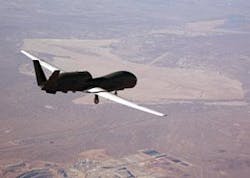UAV market outlook strong
By John McHale
Defense and aerospace analysts say the most vibrant growth in the industry lays with unmanned systems, specifically unmanned aerial vehicles (UAVs).
The global war on terrorism has prompted the United States to pump significant amounts of money into its Unmanned Aerial Vehicle programs, says Forecast International analyst Larry Dickerson.
Dickerson says the market for UAV reconnaissance systems, including air vehicles, ground control equipment, and payloads, is expected to be worth $13.6 billion through 2014. “Although the popularity of UAVs continues to grow worldwide, the U.S. is by far the largest single market,” he says.
“The most significant catalyst to this market has been the enormous growth of interest in UAVs by the U.S. military, tied to the general trend toward information warfare and net-centric systems,” says Steve Zaloga, senior analyst for the Teal Group in Fairfax, Va., and first author of its 2008 market study. “UAVs are a key element in the intelligence, surveillance, and reconnaissance (ISR) portion of this revolution, and they are expanding into other missions as well with the advent of hunter-killer UAVs.”
The Teal Group’s 2008 market study estimates that UAV spending will more than double over the next decade from current worldwide UAV expenditures of $3.4 billion annually to $7.3 billion within a decade, totaling close to $55 billion in the next 10 years.
The study suggests that the U.S will account for 73 percent of the worldwide research, development, test, and evaluation (RDT&E) spending on UAV technology over the next decade, and about 59 percent of the procurement. These U.S. expenditures represent higher shares of the aerospace market than for worldwide defense spending in general, with the U.S. accounting for about 67 percent of total worldwide defense RDT&E spending and 37 percent of procurement spending, according to forecasts in International Defense Briefing, another Teal Group competitive intelligence service.
The fifth edition of the sector study, “World Unmanned Aerial Vehicle Systems, Market Profile and Forecast 2008,” examines the worldwide requirements for UAVs, including UAV payloads, and provides 10-year forecasts by country, region, and class of UAVs.
The 2008 study also provides 10-year funding and production forecasts for the wide range of UAV payloads, including Electro-Optic/Infrared Sensors, Synthetic Aperture Radars (SARs), SIGINT and EW Systems, C4I Systems, and CBRN Sensors.
“The payload portion of the 2008 study includes expanded sensor forecasts, including many new systems and system types,” says Dr. David Rockwell, second author of the new UAV study. The U.S. Air Force has stated ISR is “the centerpiece of our global war on terrorism,” and major RDT&E efforts are bringing large-aircraft capabilities to smaller and smaller UAVs, including mini-SARs and chem/bio sensors.
The 2008 study also includes a UAV Manufacturers Market Overview that reflects the worldwide UAV market “as one of the hottest areas of growth for defense and aerospace companies,” says Philip Finnegan, third author of the new UAV study.
The new UAV study doubles the number of companies covered. “The dynamism of the UAV market means that European companies are becoming increasingly important, so we will add Thales, Safran, and EMT.”
Analysts at Frost & Sullivan also see the European UAV market performing well, especially with mini-UAVs.
“As the European military UAV market takes off, opportunities for smaller systems have proliferated,” notes Frost & Sullivan senior analyst Antony Adie. “However, consolidation will rationalize the market as it matures.”
Whether at command level or with the front line infantryman fighting the “Three Block War,” mini-UAVs provide real-time situational awareness on the usually dispersed and complex modern battlefield, Frost analysts say. Mini-UAVs give a combat unit that vital glimpse “over the hill,” or around the corner of the next building. Their comparatively low cost and increasingly sophisticated sensor technologies mean that the use of small and mini unmanned aerial systems (S/MUAS) will proliferate across the military market in the near future. Additionally, their effectiveness and versatility has captured the interest of a variety of potential civilian users.
“Smaller companies can successfully compete against larger players, as AAI Corp., General Atomics, and AeroVironment have all shown,” Teal’s Finnegan says. In addition to continuing coverage of these successful small U.S. companies, new ones have been added, including Insitu, Aurora Flight Sciences, Swift Engineering, and Proxy Aviation Systems.
“Our overview tracks the widely varying approaches being taken by these key companies, ranging from outright acquisitions, to teaming arrangements and internal development of new UAV systems,” Finnegan adds.
“American firms have a value share of more than 50 percent of this market and could gain control of a further 5 to 10 percent over the next decade," Forecast International’s Dickerson says.
The dominance of these American companies can be attributed in part to the large U.S. requirement and the high cost of certain systems it is currently acquiring, such as the RQ-4 Global Hawk UAV. “The value of Global Hawk production over the next 10 years could reach $3.5 billion,” he adds. Northrop Grumman believes that sales of the Global Hawk air vehicles could exceed 200 units, Dickerson says.

